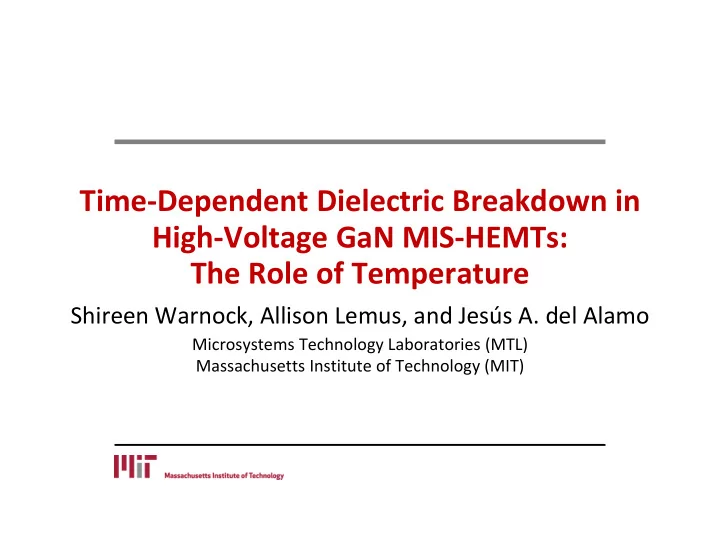

Time‐Dependent Dielectric Breakdown in High‐Voltage GaN MIS‐HEMTs: The Role of Temperature Shireen Warnock, Allison Lemus, and Jesús A. del Alamo Microsystems Technology Laboratories (MTL) Massachusetts Institute of Technology (MIT)
Purpose • Understand time‐dependent dielectric breakdown (TDDB) in GaN MIS‐HEMTs • Explore progressive breakdown (PBD) as a means of better understanding physics of gate dielectric degradation 2
Motivation GaN Field‐Effect Transistors (FETs) promising for high‐voltage power applications more efficient & smaller footprint 3
Time‐Dependent Dielectric Breakdown • High gate bias → defect genera�on → catastrophic oxide breakdown • Often dictates lifetime of chip Typical TDDB experiments: Si high‐k MOSFETs Modeling defect formation R. Degraeve, MR 2009 T. Kauerauf, EDL 2005 4
Dielectric Reliability in GaN FETs AlGaN/GaN metal‐insulator‐semiconductor high electron mobility transistors (MIS‐HEMTs) • Goals of this work: ‒ What does TDDB look like in GaN MIS‐HEMTs? ‒ What is the temperature dependence of TDDB and what does it tell us about breakdown physics? 5
TDDB in GaN MIS‐HEMTs ALD Al 2 O 3 RTCVD SiN PEALD SiN T.‐L. Wu, IRPS 2013 G. Meneghesso, MR 2015 • Classic TDDB observed • Studies to date focus largely on: breakdown statistics, lifetime extrapolation, evaluating different dielectrics • Goal of this work: temperature dependence of TDDB 6
Experimental Methodology & Breakdown Statistics 7
Classic TDDB Experiment Constant gate‐voltage stress: hard breakdown (HBD) I G trapping SILC S. Warnock, CS MANTECH 2015 Experiment gives time to breakdown and shows generation of stress‐induced leakage current (SILC) 8
Observing Progressive Breakdown Classic TDDB experiment: V Gstress =12.6 V, V DS =0 V Near breakdown, I G becomes noisy progressive breakdown (PBD) 9
Observing Progressive Breakdown Classic TDDB experiment: V Gstress =12.6 V, V DS =0 V t HBD t 1BD t PBD • Time‐to‐first‐breakdown t 1BD : I G noise appears • Hard breakdown (HBD) time t HBD : Jump in I G , device no longer operational • t PBD : duration of progressive breakdown (PBD) 10
GaN Gate Breakdown Statistics Statistics for time‐to‐first‐breakdown t 1BD and hard breakdown t HBD` β=5.5 β=5.9 S. Warnock, IRPS 2016 • Weibull distribution : ln[‐ln(1‐F)] = βln(t) ‐ βln(η) • Nearly parallel statistics common origin for t 1BD and t HBD 11
Understanding the Role of Temperature 12
TDDB Across Temperature Constant gate‐voltage TDDB stress: T ↑ • As T ↑, I G ↑ • I G evolution at each T nearly identical across 10 devices uniform device fabrication 13
GaN Breakdown Statistics Weibull plots of time‐to‐first breakdown t 1BD (left) and hard breakdown time t HBD (right) • As T ↑, t HBD and t 1BD ↓ • Variation in Weibull slopes due to small sample size 14
GaN Breakdown Statistics Correlation between time‐to‐first‐breakdown t 1BD and PBD duration t PBD (following E. Wu, IEDM 2007) V GS,stress =13 V V DS,stress =0 V • As T↓, t PBD and t 1BD ↑ • t 1BD and t PBD independent of one another after first breakdown, defects generated at random until HBD occurs 15
After Hard Breakdown Lateral location of BD path: measure I D /(I S +I D ) at V DS =0 V L GS L GD V GS = ‐0.7 V V DS = 0 V (following R. Degraeve, IRPS 2001) • Spread of BD locations across channel, no particular trend with T • L GD > L GS → current preferen�ally flows through source terminal • Fit line gives R Daccess =5*R Saccess 16
TDDB Activation Energy Take the time t BD where Weibull function = 0 (cumulative failure F=63.2%) • E A for first breakdown, hard breakdown nearly identical → likely common physical origin • Very small E A , unlike reports in Si CMOS or other GaN MIS‐HEMTs 17
I G Evolution During PBD I G during PBD follows exponential trend, consistent with PBD in Si t 1BD , I G1 Fit with equation of the form I G1 *exp([t‐t 1BD ]/τ PBD ) 18
I G Evolution During PBD Fit PBD regime with exponential for every measured temperature E A =79 meV • E A for avg(τ PBD ) ~ 79 meV • Close to E A for 1BD, HBD suggests similar underlying mechanism 19
I G Noise During PBD • Does I G noise increase or decrease with temperature? • Find standard deviation of I G and normalize by average I G (because I G ↑ as T ↑) No trend over temperature origins of noise likely to be tunneling phenomenon 20
Conclusions • Developed methodology to study TDDB and explore PBD in GaN MIS‐HEMTs • Classic t 1BD and t HBD statistics ‒ Common physical origin for first breakdown and hard breakdown: parallel statistics, similar activation energies ‒ However, t 1BD not predictive of t HBD • PBD characteristic time constant, τ PBD , has E A near that of 1BD, HBD (≈60‐80 meV) • I G noise shows no temperature trend, suggests tunneling 21
Acknowledgements 22
Questions? 23
Recommend
More recommend